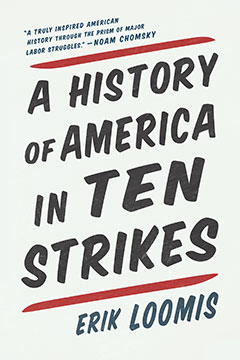Booknotes: A History of America in Ten Strikes by Erik Loomis

Finished 8/16/20
A rich but readable account of American labor history that is refreshingly honest about both its successes and its challenges.
Eric Loomis is a professor of history at the University of Rhode Island, but is perhaps more well known as a History blogger at Lawyers, Guns, and Money, and for his “This Day in Labor History” series. This book is a cogent coalescence of that series, which provides a periodization of American labor history using ten historical strikes to exemplify the state of labor at given historical moments. These are
- The Lowell textile strikes of the 1830s
- The strikes of enslaved Africans during the Civil War
- The Strikes for the Eight Hour Day in the “Gilded Age” of the 1880s and 90s
- The Anthracite strikes, particularly the Ludlow, Colorado coal strike and massacre at the dawn of the 20th century
- The “Bread and Roses” strike and the IWW in the 1910s and 20s
- The Flint sit-down strike of 1937 and the New Deal
- The Oakland General Strike of 1946 and post-war Unionism
- The Lordstown strike of 1972
- The Air Traffic Controller’s Strike of 1981
- The Justice for Janitors movement of the 1980s and 90s
The book is filled with an astonishing and interesting cast of characters, and Loomis works hard to bring to life the stories of everyday, working people and the struggles they faced. Perhaps because of his blogging, Loomis is a gifted and clear writer, and despite its broad reach, the book is eminently readable, while still being filled with plenty of wild details, and astonishing stories and quotes. Interesting and complicated characters like Sarah Bagley (who organized arguably the first Women’s Union in the US), or the story of the tensions in the Oakland General strike are rich and rewarding. And the book is full of anecdotes and details, such that I suspect even people relatively knowledgeable about American labor history will find something they didn’t know before (I certainly did).
Loomis chooses to focus on the diversity and social tensions that have run through the US labor movement. Loomis is not shy about discussing the ways in which race and ethnicity have structured and organized the forms that labor organization and class consciousness have taken in America. He follows Du Bois in seeing the Civil War as being won due to the labor action of enslaved African-Americans, and he casts a clear eye on the racism of swaths of the labor movement in the 19th and 20th centuries, with rich discussions of the AFL’s failure to organize non-white or marginally White workers in the 19th century, or the violent pushback by White workers and Southern elites when the CIO attempted to organize Black and White workers in the 1940s. There are also clear (though brief) discussions of the role of race in the election of Donald Trump and his courting of the putative “White Working Class” (though I have found other analyses more useful in understanding 2016).
More explicitly than most academic histories, Loomis is clear that he wants the book to serve as a guide for activists and political supporters of working people. He begins the book with a discussion of the recent teacher’s strikes in West Virginia, which were ultimately successful. And his conclusion argues that we “live in a new Gilded Age” of rampant income inequality and exploitation of working people. He sums the book up by arguing what he sees as the main lessons of American labor history. These are that labor wins when it focuses both on organizing and on political persuasion, that a racially diverse labor movement is ultimately stronger than a racially homogenous one, and that successful labor movements recognize the wide range of laboring activities rather than focusing on just a few (re: industrial) forms of work.
The book is a clear and digestible history, and a call to arms to make a more just and equitable society, using the lessons of past attempts to do the same. Well worth the time of anyone who wants to change the world.
